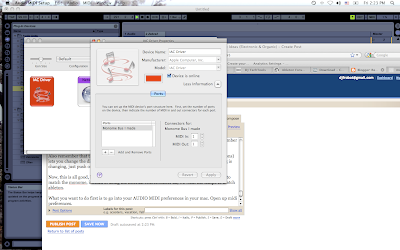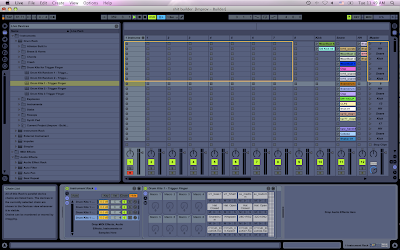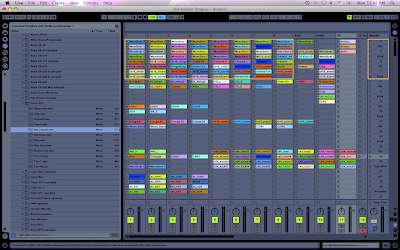
Todays Session Above
I started a brand new track today. I still have 2 sitting around that I havent finished, but I was in the mood for making something new today so I started. I did a few things different to my normal procedure to which are worth noting.
I have decide to save 2 separate ableton sets per song I do. One is my track compose set which has 8 audio tracks, and a few synth tracks....and everything else is added one by one as I go on. Like ive said before, I usually build a backbone to a track, and then build off of it. In the picture above, I havent even saved the backbone to the compose section, just setting up backbone scenes to record in.
Recently, I made a new ableton template set which is used for digital synthesis creation...so now, I am bouncing between the 2 sets to make my track. What I am doing, is starting within my creation set...making some nice fundemental loops with kicks, high hats, some drums, etc. Then, I copy those into my digital synthesis set. (just for background music purposes). Then, within my digital synthesis set, I just start recording TONS of samples using my monome, drum racks, and kits. I record midi loops, then audio loops, and save tons. Im not really sure which i am going to use, but by making 10 similar samples with the same midi notes, and effecting different parts of them...when I put them back into my compose section, I have a bundle to choose from. Its definitely making things sound more techy when playing with neat effects within a softsynth....ones that you wouldnt normaly play with. I was messing with a comb filter, waveshaper, and some other things today. Great techy sounds.
Also, today, I tried a different kind of bass sound. Almost sub bass, really tech house sound...but it still has a rolling melody to the bassline. Makes a nice cool sound. I used 1 hit bass samples rather than a softsynth to make the sound, and just transposed the samples and cut them up to make a nice melody. The whole track sounds different than the last ones...although there isnt much too it now, only a backbone...which I will record into compose tomorrow. (day off!)
Technical notes not to forget for tomorrow -
Filter the kick in the beginning with high pass or band pass. High Q.
Alternate track 3s delays throughout, but not sequentially.
Come in off a low pass for the synth lead...starting at 1 oclock or 12 oclock.
Add a new snare on top of the small one I have.
Make sure not to be to 4/4 bar changing. Add some off hits.
Another cool thing about this track is that I made a nice bass line in an OFF time...so I will actually change the time signature of this song half way....sounding really creative.
Well thats it for today!
FroBot
I have decide to save 2 separate ableton sets per song I do. One is my track compose set which has 8 audio tracks, and a few synth tracks....and everything else is added one by one as I go on. Like ive said before, I usually build a backbone to a track, and then build off of it. In the picture above, I havent even saved the backbone to the compose section, just setting up backbone scenes to record in.
Recently, I made a new ableton template set which is used for digital synthesis creation...so now, I am bouncing between the 2 sets to make my track. What I am doing, is starting within my creation set...making some nice fundemental loops with kicks, high hats, some drums, etc. Then, I copy those into my digital synthesis set. (just for background music purposes). Then, within my digital synthesis set, I just start recording TONS of samples using my monome, drum racks, and kits. I record midi loops, then audio loops, and save tons. Im not really sure which i am going to use, but by making 10 similar samples with the same midi notes, and effecting different parts of them...when I put them back into my compose section, I have a bundle to choose from. Its definitely making things sound more techy when playing with neat effects within a softsynth....ones that you wouldnt normaly play with. I was messing with a comb filter, waveshaper, and some other things today. Great techy sounds.
Also, today, I tried a different kind of bass sound. Almost sub bass, really tech house sound...but it still has a rolling melody to the bassline. Makes a nice cool sound. I used 1 hit bass samples rather than a softsynth to make the sound, and just transposed the samples and cut them up to make a nice melody. The whole track sounds different than the last ones...although there isnt much too it now, only a backbone...which I will record into compose tomorrow. (day off!)
Technical notes not to forget for tomorrow -
Filter the kick in the beginning with high pass or band pass. High Q.
Alternate track 3s delays throughout, but not sequentially.
Come in off a low pass for the synth lead...starting at 1 oclock or 12 oclock.
Add a new snare on top of the small one I have.
Make sure not to be to 4/4 bar changing. Add some off hits.
Another cool thing about this track is that I made a nice bass line in an OFF time...so I will actually change the time signature of this song half way....sounding really creative.
Well thats it for today!
FroBot





























